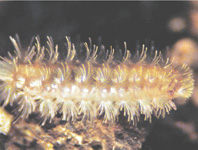Abstract
Few surveys on benthic fauna have been performed on the island of Madeira (Alves et al. 2003 and references therein), and the first sponge specimens were collected opportunistically (Johnson 1863, 1899; Topsent 1904, 1928). Porifera can be considered one of the least studied phyla in the Madeira archipelago, within the Lusitanian province. This is not the case for other regions as the Mediterranean (Boury-Esnault 1971 and references therein), Alboran Sea (Carballo 1994), Canary Islands (Cruz 2002), and the Azores (Topsent 1904; Boury-Esnault & Lopes 1985; Xavier 2009), where sponges have been more thoroughly studied.
References
Alves, F.M.A., Chícharo, L.M., Serrão, E. & Abreu, A.D. (2003) Grazing by Diadema antillarum (Philippi) upon algal communities on rocky substrates. Scientia Marina, 67, 307–311.
https://dx.doi.org/10.3989/scimar.2003.67n3307Araújo, M.F., Cruz, A., Humanes, M., Lopes, M.T., Silva, J.A.L. & Silva, J.J.R.F. (1999) Elemental composition of Demospongiae from the eastern Atlantic coastal waters. Chemical Speciation and Bioavailability, 11, 25–36.
https://doi.org/10.3184/095422999782775735Araújo, R. & Wirtz, P. (2015) The decapod crustaceans of Madeira Island–an annotated checklist. Spixiana, 38, 205–218.
Augier, H. (1985) Première contribution à l’étude et à la cartographie des biocenoses marines benthiques de l’île de Madère. Boletim do Museu Municipal do Funchal, 37, 86–129.
Boury-Esnault, N. (1971) Spongiaires de la zone rocheuse de Banyuls-sur-Mer. I. - Écologie et répartition. Vie Milieu, Série B, 22, 159–192.
Boury-Esnault, N. & Lopes, M.T. (1985) Les Démosponges littorales de l’archipel des Açores. Annales de l’Institut Océanographique, 61, 149–225.
Boury-Esnault, N. & Rützler, K. (1997) Thesaurus of sponge morphology. Smithsonian Contributions to Zoology, 596, 1–55.
https://doi.org/10.5479/si.00810282.596Bowerbank, J.S. (1866) A Monograph of the British Spongiadae. Vol. 2. Ray Society, London, 388 pp.
Carballo, J.L. (1994) Taxonomia, zoogeografia y autoecologia de los Poríferos del Estrecho de Gibraltar. Tésis Doctoral, Universidad de Sevilla, Seville, 331 pp.
Cruz, T. (2002) Esponjas marinas de Canarias. Banco de datos de biodiversidad de Canarias. Consejería de Política Territorial y Medio Ambiente, Gobierno de Canarias, Santa Cruz de Tenerife, 258 pp.
De Weerdt, W.H. & Van Soest, R.W.M. (1986) Marine shallow-water Haplosclerida (Porifera) from the South-Eastern part of the North Atlantic Ocean. Zoologische Verhandelingen, 225, 1–49.
Duran, S., Giribet, G. & Turon, X. (2004) Phylogeographical history of the sponge Crambe crambe (Porifera, Poecilosclerida): range expansion and recent invasion of the Macaronesian islands from the Mediterranean Sea. Molecular Ecology, 13, 109–122.
https://doi.org/10.1046/j.1365-294X.2003.02022.xGrant, R.E. (1826) Notice of a New Zoophyte (Cliona celata Gr.) from the Firth of Forth. Edinburgh New Philosophical Journal, 1, 78–81.
Hooper, J.N.A. (1996) Revision of Microcionidae (Porifera: Poecilosclerida: Demospongiae) with description of Australian species. Memoirs of the Queensland Museum, 40, 1–626.
Hooper, J.N.A. (1997) Sponge guide. Guide to sponge collection and identification. Queensland Museum, Brisbane, 134 pp.
Johnson, J.Y. (1863) Description of a new siliceous sponge from the coast of Madeira. Proceedings of the Scientific Meetings of the Zoological Society of London, 7, 257–259.
Johnson, J.Y. (1899) Notes on some sponges belonging to the Clionidae obtained at Madeira. Journal of the Royal Microscopical Society, 9, 461–463.
https://doi.org/10.1111/j.1365-2818.1899.tb00164.xLopes, M.T. (1995) Littoral sponges from Selvagens islands. Boletim do Museu Municipal Funchal, 4, 387–394.
Morrow, C. & Cárdenas, P. (2015) Proposal for a revised classification of the Demospongiae (Porifera). Frontiers in Zoology, 12, 1–27.
https://doi.org/10.1186/s12983-015-0099-8Schmidt, O. (1862) Die Spongien des adriatischen Meeres. W. Engelmann, Leipzig, viii + 88, 7 pls.
Schulze, F.E. (1878) Untersuchungen über den Bau und die Entwicklung der Spongien. Vierte Mittheilung. Die Familie der Aplysinidae. Zeitschrift für wissenschaftliche Zoologie, 30, 379–420, pls. XXI–XXIV.
Scopoli, J.A. (1772) Flora carniolica exhibens plantas Carnioliae indigenas et distributas in classes, genera, species, varietates, ordine Linnaeano. Vol. II. Editio Secunda Avcta et Reformata. Sponges. impensis Ioannis Pavli Kravss, Vindobonae, 667 pp. [pp. 411–413]
Topsent, E. (1891) Essai sur la faune des spongiaires de Roscoff. Archives de Zoologie expérimentale et générale, 9, 523–554.
Topsent, E. (1904) Spongiaires des Açores. Résultats des Campagnes Scientifiques accomplies par le Prince Albert I Monaco, 25, 1–280.
https://doi.org/10.5962/bhl.title.61852Topsent, E. (1928) Spongiaires de l’Atlantique et de la Méditerranée, provenant des croisières du Prince Albert Ier de Monaco, Résultats des Campagnes Scientifiques accomplies par le Prince Albert I Monaco, 74, 1–376.
Van Soest, R.W.M., Beglinger, E.J. & Voogd, N.J. (2013) Microcionid sponges from Northwest Africa and the Macaronesian Islands (Porifera, Demospongiae, Poecilosclerida). Zoologische Mededelingen, 87, 275–404.
Vio, G. (1792) Della natura delle Spongie di Mare, e particolarmente delle più rare, che allignano nel Golfo di Smirne. Lettera del P. Lettore D. Guido Vio. In: Olivi, G. Zoologia Adriatica, 1792, pp. xi–xxxi. [Bassano]
Xavier, J.R. (2009) Biodiversity and phylogeography of Northeast Atlantic and Mediterranean sponges. PhD thesis, University of Amsterdam, Amsterdam, 174 pp.
Xavier, J.R., Cárdenas, P., Cristobo, J., Van Soest, R. & Rapp, H.T. (2015) Systematics and biodiversity of deep-sea sponges of the Atlanto-Mediterranean region. Journal of the Marine Biological Association of the United Kingdom, 95, 1285–1286.
https://doi.org/10.1017/S0025315415001514Wirtz, P., Fricke, R. & Biscoito, M.J. (2008) The coastal fishes of Madeira Island–new records and an annotated check-list. Zootaxa, 1715, 1–26.
Wirtz, P. (2013) Seven invertebrates new for the marine fauna of Madeira Archipelago. Arquipélago. Life and Marine Sciences, 2013, 31.

